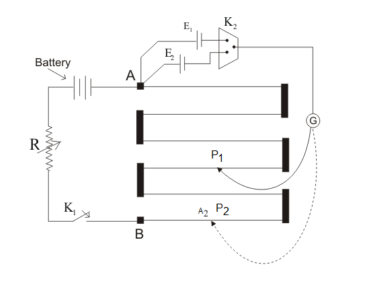
Assertion: The emf of the driver cell in the potentiometer experiment should be greater than the emf of the cell to be determined.
Reason: The fall of potential across the potentiometer wire should not be less than the emf of the cell to be determined.
(A) Both Assertion and Reason are correct and Reason is the correct explanation for Assertion
(B) Both Assertion and Reason are correct but Reason is not the correct explanation for Assertion
(C) Assertion is correct but Reason is incorrect
(D) Assertion is incorrect but Reason is correct
Answer
514.8k+ views
Hint: If emf of the driver cell in the potentiometer is not greater than the emf of the cell, the fall of potential across the potentiometer wire would not be greater than the emf of the cell to be determined and there will be no balance point.
Complete step by step solution:
In this experiment, we determine the emf of a cell which is not known to us using a potentiometer. A potentiometer has a wire which is generally several meters long. It is stretched between two points A and B on a wooden board. We take two cells with emf’s \[{E_1}{\text{ }}\] and ${E_2}$ out of which one of them is known to us. The positive terminal of \[{E_1}\] is connected to the end A and negative terminal to a jockey and galvanometer.
When a steady current starts flowing through the circuit, we start moving our jockey along wire AB in a way such that the deflection in the galvanometer becomes zero. This is our balance point.

At this point the potential drop across this particular length of wire balances the emf When a steady current starts flowing through the circuit, we start moving our jockey along wire AB in a way such that the deflection in the galvanometer becomes zero. This is our balance point. At this point the potential drop across this particular length of wire balances the emf \[{E_1}\] that we are supposed to determine. Then we use the formula: \[{E_1} = \dfrac{{{L_1}}}{{{L_2}}}{E_2}\] to determine \[{E_1}\].
However, if the emf of the driving cell (\[{E_2}\]) was not greater than the emf to be determined (\[{E_1}\]), the potential drop across wire AB would also have been lesser than the emf to be determined (\[{E_1}\]) and we would never have obtained a balance point, i.e. \[{L_1}\] or \[{L_2}\].
Therefore, both the Assertion and Reason given in the question are correct and the given Reason is also the correct explanation for the Assertion.
Option (A) is correct.
Note: The basic principle on which a potentiometer works is that the potential drop across the potentiometer wire is directly proportional to its length$ \Rightarrow E \propto L \Rightarrow \dfrac{{{E_1}}}{{{E_2}}} = \dfrac{{{L_1}}}{{{L_2}}} \Rightarrow {E_1} = \dfrac{{{L_1}}}{{{L_2}}}{E_2}$.
Complete step by step solution:
In this experiment, we determine the emf of a cell which is not known to us using a potentiometer. A potentiometer has a wire which is generally several meters long. It is stretched between two points A and B on a wooden board. We take two cells with emf’s \[{E_1}{\text{ }}\] and ${E_2}$ out of which one of them is known to us. The positive terminal of \[{E_1}\] is connected to the end A and negative terminal to a jockey and galvanometer.
When a steady current starts flowing through the circuit, we start moving our jockey along wire AB in a way such that the deflection in the galvanometer becomes zero. This is our balance point.

At this point the potential drop across this particular length of wire balances the emf When a steady current starts flowing through the circuit, we start moving our jockey along wire AB in a way such that the deflection in the galvanometer becomes zero. This is our balance point. At this point the potential drop across this particular length of wire balances the emf \[{E_1}\] that we are supposed to determine. Then we use the formula: \[{E_1} = \dfrac{{{L_1}}}{{{L_2}}}{E_2}\] to determine \[{E_1}\].
However, if the emf of the driving cell (\[{E_2}\]) was not greater than the emf to be determined (\[{E_1}\]), the potential drop across wire AB would also have been lesser than the emf to be determined (\[{E_1}\]) and we would never have obtained a balance point, i.e. \[{L_1}\] or \[{L_2}\].
Therefore, both the Assertion and Reason given in the question are correct and the given Reason is also the correct explanation for the Assertion.
Option (A) is correct.
Note: The basic principle on which a potentiometer works is that the potential drop across the potentiometer wire is directly proportional to its length$ \Rightarrow E \propto L \Rightarrow \dfrac{{{E_1}}}{{{E_2}}} = \dfrac{{{L_1}}}{{{L_2}}} \Rightarrow {E_1} = \dfrac{{{L_1}}}{{{L_2}}}{E_2}$.
Recently Updated Pages
Arithmetic, Geometric & Harmonic Progressions Explained

Cartesian Form of Vector Explained: Formula, Examples & Uses

Apparent Frequency Explained: Formula, Uses & Examples

Calorimetry: Definition, Principles & Calculations

Centrifugal Force Explained: Definition, Formula & Examples

Charge in a Magnetic Field: Definition, Formula & Examples

Trending doubts
JEE Main 2026: Application Form Open, Exam Dates, Syllabus, Eligibility & Question Papers

Derivation of Equation of Trajectory Explained for Students

Hybridisation in Chemistry – Concept, Types & Applications

Understanding the Angle of Deviation in a Prism

Understanding Collisions: Types and Examples for Students

Understanding Atomic Structure for Beginners

Other Pages
JEE Advanced Marks vs Ranks 2025: Understanding Category-wise Qualifying Marks and Previous Year Cut-offs

How to Convert a Galvanometer into an Ammeter or Voltmeter

Ideal and Non-Ideal Solutions Explained for Class 12 Chemistry

Degree of Dissociation: Meaning, Formula, Calculation & Uses

Understanding Electromagnetic Waves and Their Importance

Understanding Average and RMS Value in Electrical Circuits




